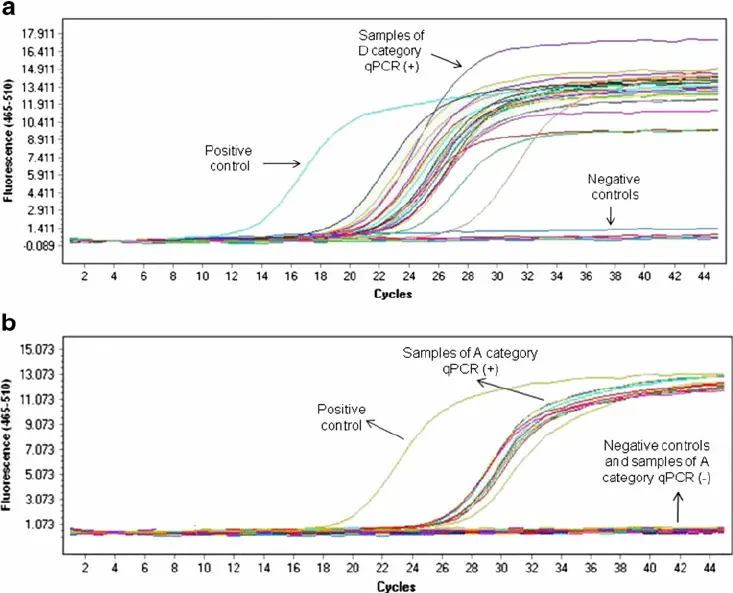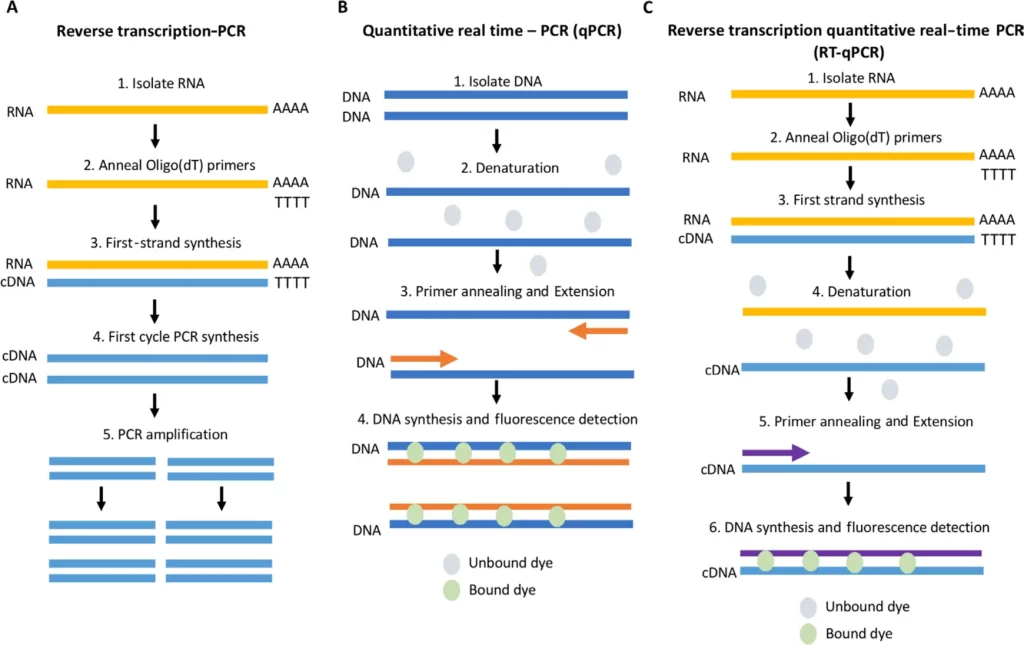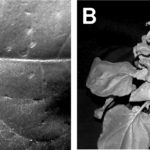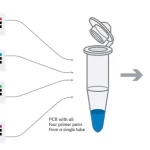qPCR and Greenhouses
Today, we’re exploring the world of qPCR, or quantitative Polymerase Chain Reaction, for greenhouses and discovering why it’s essential for anyone in the business of growing.
The Basics of qPCR
qPCR is a lab technique used to amplify and quantify DNA. Think of it as turning a tiny, almost invisible piece of DNA in your sample into something big enough to examine closely. It’s like magnifying a needle in a haystack to find it and count precisely how many needles are there.
Practically, it makes detecting things with DNA (or RNA through a similar process) easy. This includes disease-causing organisms or even plants themselves.

See how Healthy Hydroponics detects viable ToBRFV.
Understanding Different types of PCR
- PCR (Polymerase Chain Reaction): Think of this as a DNA copier. It can take a tiny piece of plant DNA and make many copies. This helps scientists study which traits make a plant resist pests or grow faster, and it can also identify the DNA of a plant disease from a small sample.
- qPCR (Quantitative PCR or Real-Time PCR): This advanced version not only copies plant DNA but also measures how much DNA is made as it copies. This is very useful in agriculture to estimate how much of a specific disease is in a crop or to check how strongly a plant expresses a desirable trait under different conditions.
- RT-qPCR (Reverse Transcription Quantitative PCR): This method is used when scientists want to look at RNA (this is like a cousin to DNA and is essential for various cell processes), like when checking which genes are active in a plant during drought or when fighting an infection. First, it converts RNA from the plant into DNA, then copies and measures it, helping researchers understand plant responses to different stresses.
- Multiplex PCR: This technique copies multiple DNA segments at once. It’s like running several DNA tests at the same time. This is handy for quickly screening a batch of plants for various diseases or breeding programs where many traits must be checked simultaneously.
- And more!

Why qPCR Matters for Greenhouse Operators
For those growing crops to nurturing new varieties, qPCR is helpful for several reasons:
- Disease Detection: Early detection of plant diseases can save your crops. qPCR can identify the DNA of harmful pathogens, even before symptoms appear. It’s like catching a thief before they break into your greenhouse.
- Genetic Analysis: Want to know if your plants have the desired genetic traits for yield or disease resistance? qPCR can confirm this by detecting specific DNA sequences.
- Quality Control: Ensure your plants are what they’re supposed to be. qPCR can verify the identity of plant species or varieties, ensuring you’re growing and selling the real deal.
Advantages and Limitations of qPCR for Greenhouses
qPCR comes with a bunch of perks:
- Fast: allowing you to get results faster than traditional methods.
- Sensitive: capable of detecting even the smallest amounts of DNA.
- Specific: meaning it can distinguish between closely related DNA sequences–allowing you to feel confident about the results.
However, qPCR can be costly and requires specialized equipment and reagents. It also demands some expertise to perform and interpret the results correctly. Plus, the quality of your starting material (like plant tissues or water) can affect the accuracy of your results.
That’s why we at Healthy Hydroponics provide the expertise and equipment for greenhouse operators as a service. We want this technology accessible to growers and everyone who supports a greenhouse operation.
Real Life Example: Client Case Study
In a compelling case from one of our clients, a persistent issue in their greenhouse showcased the critical role qPCR can play in accurate disease diagnosis. They were growing spinach, repeatedly failing despite numerous efforts to identify and control the problem. Traditional testing methods by multiple companies and universities consistently pointed to Fusarium, a common fungal pathogen, as the culprit.
The spinach crops continued to deteriorate despite following all recommended routines and cleaning regimes for a Fusarium infection. It was a frustrating cycle: do a deep clean, see temporary improvement, and then watch the plants fail again. The repeated failures suggested something was amiss, leading to reconsidering the diagnostic approach.
This is where qPCR came into play. Unlike traditional tests with limited detection panels focusing primarily on the most common pathogens like Fusarium, qPCR enabled a broader and more detailed analysis. When our client decided to utilize qPCR to re-examine their spinach samples, the results were surprising: the real issue was not Fusarium, but Olpidium, a less common but impactful pathogen.
Olpidium is a waterborne fungus-like organism that traditional panels often overlook because it’s not typically included in routine tests. This pathogen was the actual cause behind the crop failures, thriving undetected while treatments targeted the wrong enemy.
With the precise identification provided by qPCR, our client could finally implement the correct management strategies specifically targeting Olpidium. The turnaround was dramatic. By addressing the right problem, the spinach crops recovered, and the cycle of failure was broken.
This case highlights qPCR’s invaluable role in detecting pathogens and ensuring the correct pathogens are identified, leading to practical solutions and healthier crops. It exemplifies why expanding diagnostic tools to include qPCR can be critical for greenhouse operators facing mysterious or persistent plant health issues.
The Bottom Line: qPCR for Greenhouses
qPCR is a powerful tool for anyone in the plant-growing business. It helps you keep your plants healthy, ensures they have the right genetic makeup, and ultimately, can save you time and money. While it may require an initial investment and some learning, the benefits it brings to your greenhouse operations can be immense.
So, consider how qPCR could fit into your plant care toolkit, whether you’re a seasoned greenhouse operator or just starting. It’s not just about growing plants; it’s about growing them smarter and with confidence.
References to Read
- Current and emerging trends in techniques for plant pathogen detection https://www.frontiersin.org/journals/plant-science/articles/10.3389/fpls.2023.1120968/full
- A beginner’s guide to RT-PCR, qPCR and RT-qPCR https://portlandpress.com/biochemist/article/42/3/48/225280/A-beginner-s-guide-to-RT-PCR-qPCR-and-RT-qPCR
- qPCR Applications for the Determination of the Biological Age https://pubmed.ncbi.nlm.nih.gov/31578696/
- RT-qPCR Made Simple: A Comprehensive Guide on the Methods, Advantages, Disadvantages, and Everything in Between https://www.urncst.com/index.php/urncst/article/view/403
- Detection, Characterization, and Distribution of the First Case of Pepino Mosaic Virus in Aotearoa New Zealand https://pubmed.ncbi.nlm.nih.gov/37755419/
- A Quantitative PCR Method to Detect the Tomato Corky Root Rot Pathogens, Pseudopyrenochaeta lycopersici and P. terrestris https://pubmed.ncbi.nlm.nih.gov/36774576/
Banner image from: https://www.technologynetworks.com/analysis/articles/qpcr-analysis-how-a-qpcr-machine-works-and-qpcr-protocol-356835
![]()
David Santos is the CMO of Healthy Hydroponics InnoTech





